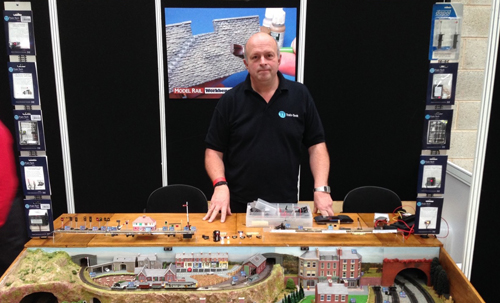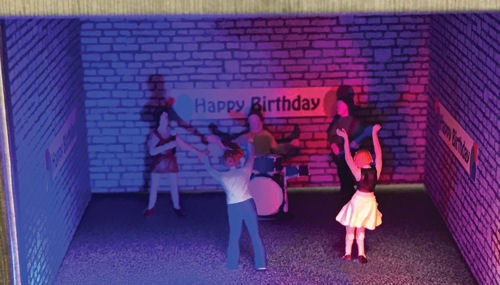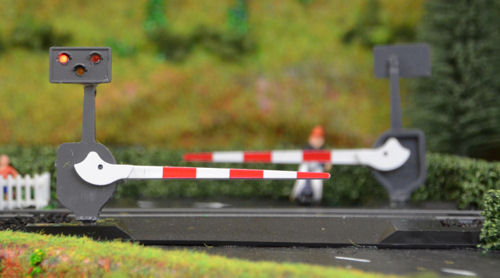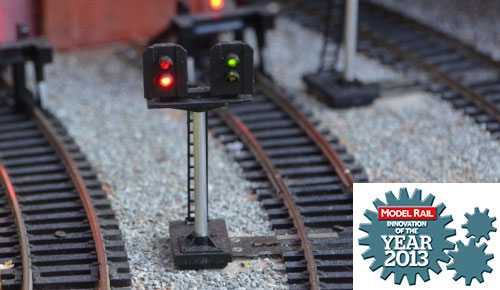

 STUART JORDAN talks to David Palmer, owner of Train-Tech.
STUART JORDAN talks to David Palmer, owner of Train-Tech.
Stuart Jordan: Train-Tech (or rather its parent company DCP Microdevelopments) has been in existence for thirty-five years, could you give us some background on how and why you entered the Model Railway industry?

David behind the Train-Tech show stand.
David Palmer: DCP (my initials) was started in 1981 in Cambridge, while serving an apprenticeship and college with Pye Electronics. I had a Saturday job working at the 'Tandy' store which started to sell home computers from other local companies like Sinclair and Acorn. It was the start of the home computer boom, and people would come into the shop and request accessories for their computers which didn't exist and so I designed some of them in my spare time, getting friends from Pye to assemble them at night. I then tested and sold them, first through the shop and then later direct by mail order which my Mum and Dad did from their house in Norfolk.
After a year of effectively doing three jobs I decided to make the leap from Pye and run DCP full time, with a couple of days a week consultancy to the shop to give me a small regular income, even though at this time I was still living in a bedsit with components stored under the bed and I couldn't even drive!
The first products were mainly add on boxes to allow home computers to measure and control things, it's strange to think that even though Train-Tech was not even a twinkle of a thought back then, I made a small N gauge model railway layout as a demonstration of my control box with passing loop and signals all being controlled from a ZX81!
Despite this exhibit, DCP interfaces found their most natural home in School Science Labs and for nearly thirty years that's what we have concentrated on, designing manufacturing and supplying dataloggers and sensors all over the world.
Then came the world financial banking crisis and the cuts ran deep into most public services, including schools, who seemed to just stop being able to buy equipment like ours almost overnight.
With five staff, premises and a legacy to protect we had to diversify and model railways was something I have always loved, and yet found some of the products so complex to understand and use. So in 2011 we had a DCP 30th birthday party where I announced to my family and friends that we were going to launch into model railway electronics with Train-Tech and hopefully bring some of our ingenuity and experience to this traditional hobby and prove that technology should make life easier, not more complicated!

The popular SFX Sound Modules, which gives you motion-activated sounds without the need of a DCC System.
SJ: What processes lead to the decision to produce a product, is it your own personal preference or feedback from customers?
DP: It's a mixture of both really, sometimes led by modellers asking 'do we make something to...' and others where we have the ideas based on a technology we have already seen or used. We rarely offer things which other companies already make, unless we believe we can make them better or much easier to use; Ease of use is at the core of everything we do as we want to encourage modellers to get involved and use technology, yet reassure them they do not need to be electronic experts to do so.
SJ: Your big release this year is the Layout Link series of products, tell us a bit about how the range fits together.
DP: Layout Link is the name we give to the system linking our new generation of products which need to 'talk' to each other. We wanted to make the link as simple as possible and work on both Digital and traditional Analogue DC layouts, the simplest possible connection being just a single wire, and that's what we have achieved with a neat socket system which just takes standard solid core 'bell' wire so no soldering is necessary either.
SJ: Was it important to you to produce a range of accessories that all worked together?
DP: Yes, compatibility is very important, and although we looked around the market there was no existing system which offered enough flexibility to allow everything to talk to each other regardless of being DCC or DC; for example there should be no reason why a Sensor Signal in the right position on a layout shouldn't also be able to trigger a level crossing, as well as link to other signals to make automatic block signalling.
SJ: Is inter-system conformity your single biggest challenge?
DP: It has been a large part of Layout Link's development and although the electronics and engineering has certainly been a challenge, the software programs within the products have been just as much of a feat, making sure that the Layout Link products we manufacture today will work with other Layout Link accessories - not just now but in the future.

The Disco effect on one of the new Smart Lights.
SJ: The new Smart Lights include some pretty cool effects; you must be looking forward to seeing what uses for them people come up with?
DP: Yes very much so, as well as classic lighting effects like Welding and Fire we have come up with some new ones like Emergency Blue and Dual Blue/Red lights, which are small enough to fit into the roof of an OO or even N gauge Oxford Diecast Police car or Fire Engine, a Disco Party light ideal for inside a Pub or Village Hall and a Television simulator which can fit into a house and project the subtle flickering and flashing of a TV screen into the room, or onto the windows. And the TTSL100 Customisable Smart Light allows a modeller to choose exactly what colour and effects they want! Just before it was released someone asked us if we made a slow flashing light for a lighthouse, and as a result we managed to get this effect squeezed in. All in a self-contained 1cm square light with just two wires which connect directly to 12 volts DC, DCC or even a 9 volt battery!
SJ: 2016 was a busy year in terms of development but are there even more new products in the development cycle right now?
DP: Well yes, we are always thinking of new ideas as well as wish lists coming from modellers themselves. One of the most frequently asked questions we are getting at the moment is whether we are going to do the Sensor Signals in N gauge (and one request for them in Z!). It has taken us two years development to get completely automatic signals fitted into the small base and post of the 4mm OO model, and at the moment we simply cannot think how to shrink that by another 50%. But we have also invested heavily in the new Level Crossing Lights and Sound models and tooled them in both OO and N with the electronics fitting under the baseboard, so we will watch feedback of those with interest and see if that points the way in which smaller signals could be made.

The new Level Crossing Gates with light and sound, available in both OO and N Scales.
SJ: Which of your products are you most proud of?
DP: I can honestly say that I am proud of them all, from the TTTT1 Track Tester and Buffer Stop Lights which instantly clip into the track, to our DCC fitted Plug-In Signals which won us the Innovation of the Year Award in just our second year.

The Plug-In Signals won the Model Rail magazine Innovation of the Year Award back in 2013.
But I guess one of the ones which I feel have made the most difference to modellers has been the SFX Sound Capsules, which bring affordable sound to any loco regardless of whether they are DCC, DC or even clockwork (which at least one customer has done!). To have someone say to you that they are so happy to have realistic sound, because they thought they would never be able to have it on their layout as either they were not digital or couldn't afford it is very gratifying.
The other development I am especially proud of is our new Sensor Signals, because I believe that many modellers would love to have working signals on their layouts, but that in reality they do not have time to drive trains, change signals and stand back and enjoy their miniature world. So we worked hard to build everything including the sensor into the signal and make them really quick and easy to install with just a single wire linking each signal. I hope and believe Sensor Signals will help modeller's train journeys around their layout really come alive!
A video produced by Train-Tech showing the Sensor Signals in action.
SJ: We often notice how busy your stand is at shows. How important is the kind of direct feedback they provide you with?
DP: It is a really important part of what we do because no matter how good an idea we think we have, it is not going to be successful unless we listen and talk to the people who we hope are going to buy them. So I personally attend nearly every exhibition Train-Tech goes to and there is always a small notebook in my pocket to note feedback, suggestions and wish lists of everyone who comes to see us.
SJ: How much resonance do you feel the Made in the UK moniker has on your products?
DP: I think this hobby is naturally quite patriotic, and like most people I am proud of this country and believe that if designed and engineered well, products can still be viably made in Britain. As well as the obvious benefits to the country there are also benefits in terms of speed of manufacture and quality control. So yes, I am proud to say that we design and manufacture everything in Great Britain.
SJ: What does the future hold for Train-Tech?
DP: We have many more ideas including further developments for the Layout Link system and we will keep innovating, making technology easy and encouraging modellers to use electronics to help bring their layouts to life!
Thanks for giving me the opportunity to tell some of our story.
SJ: Thanks for your time David.